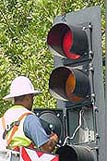2/19/2008
Houston, Texas Banks on Short YellowsYellow signal warning times in the Houston, Texas area fall short of TxDOT recommendations which helps to generate millions in revenue.

Red light cameras in the Houston, Texas area are earning millions of dollars in extra revenue by trapping motorists with short yellow signals. KPRC-TV timed the yellow duration at a number of high-speed intersections and found them to be far below the level recommended in Texas Department of Transportation (TxDOT) guidelines. At the intersection of FM 1960 and West Townsend in Humble, for example, the posted speed is 50 MPH which suggests that the yellow should last five seconds. Motorists, however, only get 3.6 seconds of warning before the red light camera begins issuing tickets.
Houston's busiest intersection, the intersection of North Freeway feeder and West Road, generates 1000 tickets a month with just 3.6 seconds of yellow. Likewise the intersection of the Interstate 10 feeder and Wayside offers just 3.6 seconds of warning and the 59 service road and Fountainview offered four seconds of yellow. Traffic on these roads flows at 45 MPH or more.
With these timings, Houston's program has been bringing in as much as $2 million a month in revenue. Although effective, the short yellows come with a significant safety penalty. The Texas Transportation Institute study found that a yellow shortened by one second from the recommended minimum will generate a 110 percent jump in the number of tickets. Increasing the yellow one second above the recommended minimum cut crashes by 40 percent. These results are reflected in Houston's own program. After a year of use, the cameras did not demonstrate any significant safety benefit.
Although a TxDOT spokesman downplayed the relevance of the short yellows because other factors must go into yellow timing calculations, national yellow signal timing guidelines developed in 1976 -- long before the advent of red light cameras in the US -- show that all of these intersections should be considered deficient (view chart). Houston's short yellow policy was adopted long before the red light cameras were installed by adopting a signal timing formula designed to reduce yellow warning periods. Dallas has also been caught banking on short yellow times.


